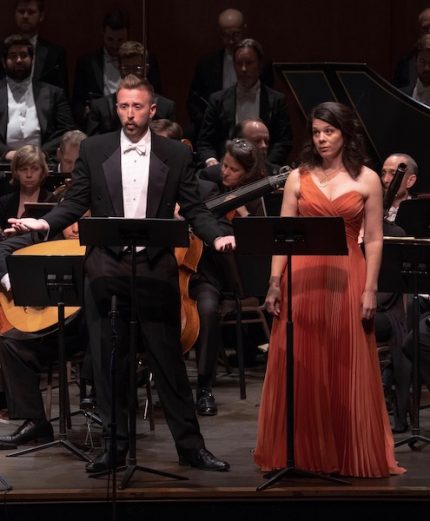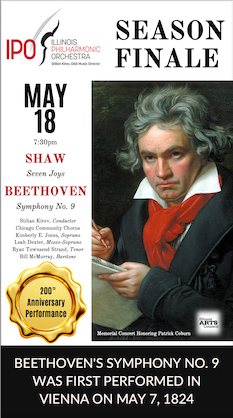Kraemer, MOB bring home the venison with engaging “hunt” program

Just when one was convinced that clever concert programming had fallen victim to populist marketing and repertory box checking, Nicholas Kraemer showed that it’s not quite a lost art.
Music of the Baroque’s principal guest conductor consistently manages to assemble quirky and interesting programs for his two annual MOB programs. Such was again the case Tuesday night at the Harris Theater when Kraemer led “La Chasse,” a generous program of mixed vocal and orchestral music inspired by “the hunt.”
As Jennifer More’s illuminating program note indicated, for royal and upper-class musical patrons of the 17th and 18th century, the formal hunt was a way to flaunt their wealth and power, and proved a hugely popular and enjoyable pastime of the nobility. For the foxes and deers, not so much.
Musically, the hunt was invariably represented by the cor de chasse or hunting horn. And indeed the French horn was prominent in nearly all the evening’s selections, with Oto Carillo, MOB’s newly appointed principal, leading horn playing that was nimble and gleaming.
Telemann’s festive Overture in D major led off the program in lively fashion. Dedicated to Ludwig VIII, aka the “hunting Landgrave,” this late Telemann work is typical of the Baroque form, with an overture followed by a suite of dances.
Kraemer has a knack for drawing gracious playing and varied tempos that feel just right in this repertoire. Fine horn playing led the sprightly Overture, which segued into a relaxed Plainte, the festive Rejouissance with swaggering oboes, a piquant Loure, and the concluding Menuet II with phrases exchanged between dueling pairs of oboes and horns.
Bach’s “Hunt Cantata” (No. 208) has maintained a hold in the repertory in no small part because it contains one of the composer’s most indelible arias, “Schafe können sicher weiden” (“Sheep may safely graze”). The work’s durability is certainly not due to its unwieldy structure, which veers from a half-hearted Arcadian lovers scena to numbing panegyrics to the work’s dedicatee, Duke Christian of Saxe-Weissenfels, another high-born hunting fanatic.
Yet, as Kraemer noted in his introduction, “amid all the sycophancy, there is some wonderful music.” In addition to Kraemer’s idiomatic Bach direction, the performance benefited by fielding a fine quartet of soloists.
Allyson McHardy brought a flexible mezzo and aptly vivacious spirit to Diana. In the thankless role of her wimpy ex-lover Endymion, Ryan Townsend Strand displayed a pliant tenor, and the duo played off each other charmingly and blended engagingly in their lilting duets.
As Pales, Veronique Filloux rendered the cantata’s showpiece aria with a refined soprano at a flowing tempo that skirted sentimentality; the woodsy obbligato recorders bestowed apt pastoral flavor. Baritone Keven Keys made the most of his brief opportunity as a firmly sung Pan. Prepared by guest chorus master Andrew Megill, the MOB ensemble brought spirited, polished singing to the choruses.
No major Baroque composer has been more neglected on MOB programs over the past two decades than Jean-Phillippe Rameau. It’s good to see that void being remedied to some degree this season, with the Ballet Suite from Castor et Pollux on tap next April and excerpts from Act IV of Hippolyte et Aricie heard Tuesday night.
The hunting scene from Rameau’s first opera fit the program’s motif, even if the oddball dramaturgy felt even stranger out of context. Still, the selections offered a worthy sampler of the French composer’s elegant vocal writing and brilliant orchestral effects.
As the huntress, Filloux sang with dedication, though the music ideally requires a voice with more body, her light soprano fitfully overwhelmed by the orchestra and chorus. McHardy brought affecting, dark-hued sorrow to Phèdre’s remorseful “Non, sa mort est mon seul ouvrage.” The chorus was an equal participant and here too sang with fine fervor.
The Canadian mezzo was also heard in Caesar’s hunting aria from Handel’s Giulio Cesare. McHardy brought able coloratura gleam to “Va tacito a nascosta,” though support here was not as consistent; the difficult solo horn obbligato was less than airtight and Kraemer’s conducting uncharacteristically metrical.
There are few more failsafe pairings than Nicholas Kraemer and music of Haydn, and so it proved again in the concluding work, the Symphony No. 73 “La Chasse.”
Kraemer has an innate sympathy for this repertoire and led a winning performance of Haydn’s “Hunt” symphony with gracious, lightly sprung rhythms, and bravura hairpin turns in dynamics and tempos. Minor debits were repeated intonation lapses from the first violins, and the horns that give the work its name could have been better projected in the finale. Still, the hunt theme went with all due galumphing energy, and Kraemer ensured that the surprise quiet coda registered in subtly delightful fashion.
Nicholas Kraemer conducts Music of the Baroque in “Bach and the Italians” November 24 and 25. baroque.org
Posted in Performances




